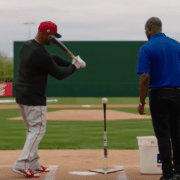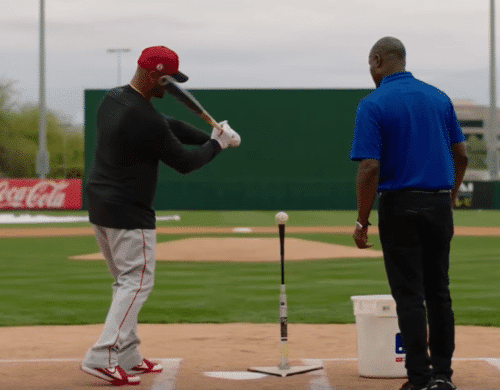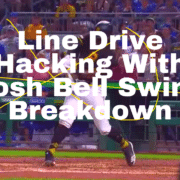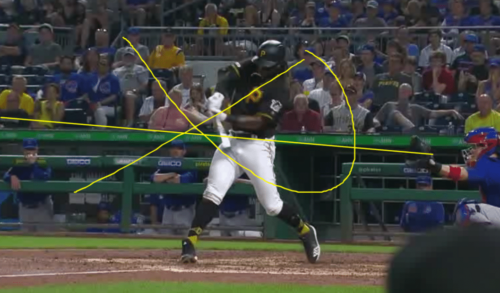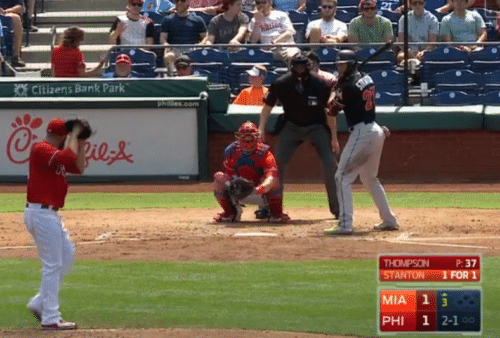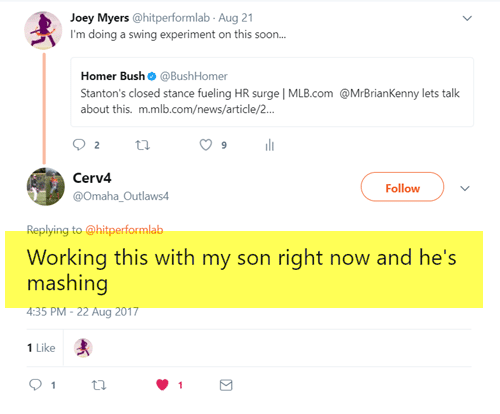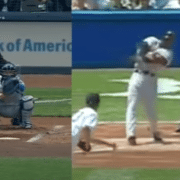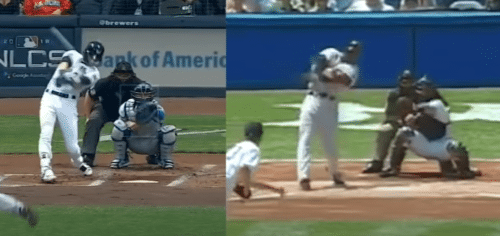This post takes a deep dive into how to fix hitting too many ground balls in baseball and softball. We discuss which part of the ball to hit if a right handed hitter is grounding out to shortstop too much (second baseman for a lefty), swinging over the top of the ball, rolling over, or has too much wrist roll. Ultimately, you’ll discover how to hit more line drives.
The UGLY Truth About Hitting Ground-Balls
(WARNING: this baseball hitting drills for kids post is a 4,500+ word beast, but your hitters will be grateful you took the time, believe me. Don’t worry, you can thank me later)
PLEASE NOTE: even though I refer to the keywords “baseball hitting drills for kids” in this post quite a bit, it’s not going to give you concrete drills to do. The objective of this post is to be a guide for coaches to more effectively pick drills to help kids hit more line drives. Although, CLICK HERE for one of my favorite posts to help hitters who have higher than average fly ball and ground balls rates to hit more line drives, it’s called ‘paradoxical intention’.
Before getting started, let me preface a couple other points:
- Getting the ball in the air is off the table in situational hitting scenarios, such as “hit-and-runs” or “move’em-overs” (but please realize, situational hitting only makes up less than 10-15% of game At-Bats).
- Getting the ball in the air doesn’t mean soft – or in some cases medium – fly-balls (we don’t teach hitters to hit soft fly-balls, just like you don’t teach hitters to hit soft ground-balls).
- Getting the ball in the air isn’t an extreme uppercut, nor is it an extreme chopping motion (our goal is to match the downward plane of the incoming pitch with the barrel – and YES, even softballs travel down).
- Remember, all line drives are “balls in the air” (I know duh, but you wouldn’t believe how many coaches try to outrun their common sense).
- Fast-pitch softball coaches, you aren’t off the hook either (the reasons WHY will become more clear as you work through this post).
Without further adieu, the RANT…
Right off the bat (pun intended), I’m going to pick a fight with the following statement, getting the panties of some coaches in a bunch, as we talk about baseball hitting drills for kids – so here goes. Drum roll please…
SCIENCE-BASED TRAINING:
Improve your hitting strategy dramatically by applying human movement principles.
Learn not only how and what to train but also the science behind the methods.
Teaching Baseball Hitting Drills For Kids To Primarily Hit Ground Balls Is Dumb
This baseball hitting drills for kids RANT has been brewing in me for some time now, and it came to a boil when I promoted the BackSpin batting tee swing experiment blog post on Facebook, titled “Baseball Batting Cage Drills: A Quick Way To Hit Less Ground-balls“…
You can CLICK HERE to read all the “classic” Facebook comments posted to the BackSpin Tee promo. A flood of baseball hitting drills for kids Facebook comments came in, mostly from coaches…
- High School to College…
- Baseball to softball…
All chiming in about how lovely it is to teach their hitters to hit the ball on the ground. And claiming how terrible of an idea the Backspin Tee is promoting more productive batted balls in the air. And like I mentioned in the preface above, a line drive is a ball in the air! They had MANY objections:
- How many games they’ve won with grounders,
- How fielding percentage is way lower than fly-balls,
- That it’s much easier to catch a fly ball,
- How great outfielders track fly balls,
- How more can go wrong with the defense keeping the ball on the ground,
- If their team hit more grounders, then they’d score more runs,
- How some of the most winningest coaches in college baseball history, Gordie Gillespie and Augie Garrido as examples, stress keeping the ball on the ground to their hitters,
- How you HAVE TO TEACH a 5’6″, 135-pound High School hitter to hit the ball on the ground because his batted ball distance maxes out at 250-feet! And,
- How even pro coaches and “great hitting instructors” never promote hitting fly-balls.
Does that about cover ALL the objections for WHY hitting a ground-ball is far superior than putting a ball in the air?

On Path, Bottom Half image courtesy: Backspintee.com
Before I get to addressing the above objections with my infamous (more than famous) Bruce Lee one-inch punch, I wanted bring this to your attention first…
You Don’t Put Backspin on a Ball by Swinging Down
Some, not all, of these Facebook comments shared how to put consistent backspin on the ball by swinging down on it.
The keyword in question here is “consistent” backspin. And we’re talking hardball and fast-pitch here, NOT slow pitch. By the way, did you know hitters can put too much backspin on the ball? It’s called a popup! We want the right amount.
These knucklehead coaches even go so far as to believe that young hitters HAVE TO swing down on the ball to get backspin because they’re not “strong enough” to put backspin on it like Major League hitters!!
Watch the 2014 MLB All-Star home-run derby highlights, and note which part of the ball these guys are hitting (top half or bottom half?)…
As the Backspin Tee guys say, “on-path bottom-half” is the answer. NEWS FLASH! This is just as true for young small hitters, as it is for MLB hitters. It’s written into the rules of Physics. Can’t break those rules if you’re on earth, sorry. And if YOU STILL don’t believe me, read this MLB article titled, “Jon Lester Shows Importance Of Launch Angle”. The article goes into to say how Lester ranks second among Major League hitting pitchers with an average Ball Exit Speed of 92.5-mph.
So, what’s the problem? Quoted from the article:
“…(He ended up with four hits on the season in 71 plate appearances, a .065/.108/.065 line.) Part of it is that, like many pitchers, contact was an issue — Lester’s 42.3 percent strikeout rate was above the 37.7 percent average for pitchers.”
How could Lester hit the ball so hard without finding much hitting success? Again, quoted from the article:
“…it’s because 19 of Lester’s 24 tracked batted balls failed to get above 7 degrees of launch angle. Sixteen of those 19 failed to even achieve positive launch angle, which is to say that he pounded the ball into the ground constantly.”
In other words, to get the ball in the air, the hitter MUST have a positive launch angle. 10+ degrees as a matter of fact. According to Rob Arthur, author from FiveThirtyEight:
“The effect of speed [running] starts to fade only when launch angles exceed 10-degrees, as exit velocity starts to take over as the biggest determinant of a batted ball’s fate.”
Did you catch that? Some coaches out there will teach their faster hitters to put the ball on the ground. Why? So they can beat out more ground-balls to infielders, they reason. Why not teach faster hitters optimized launch angles, to turn singles into doubles, doubles into triples, and triples into inside-the-park homers?
Another valuable thing about optimizing launch angles, and lack of running speed, I was working with a 14-year-old young man, and he ran like he was pulling a tractor tire. In the beginning, he was behind in Ball Exit Speed for his age (double negative!!), so guess what we worked on? RIGHT-O!! Optimizing his launch angles. It was a quick fix that got him immediate results, until we got his Ball Exit Speeds caught up…and that they eventually did.
One last thing about baseball hitting drills for kids, Aaron Miles, who played 12 years of professional baseball (9 years in the Big Leagues with White Sox, Cardinals, Rockies, and Dodgers), told me these downward swing path hitters got weeded out by AA-ball. By the way, Aaron Miles is 5’7″, 180-lbs, which is impressive that with his size he competed for 9 Major Leagues seasons and did quite well. You don’t play that long in the Big Leagues, with his size, UNLESS you’re doing something right. Success leaves clues right?!
Am I making myself clear on this ‘down swinging’ backspin issue? Negative launch angles equate to negative playing time on the field. Before I karate chop the baseball hitting drills for kids coaching objections above, I wanted to get something else off my hairy chest first…
Hitting Ground-balls have their Place
…in situational hitting, which depending on the game, can make up less than 10-15% of a team’s at-bats. Of course, we don’t want to put a ball in the air on a hit-and-run or with a slap hit. That’s dumb. Even I know that.
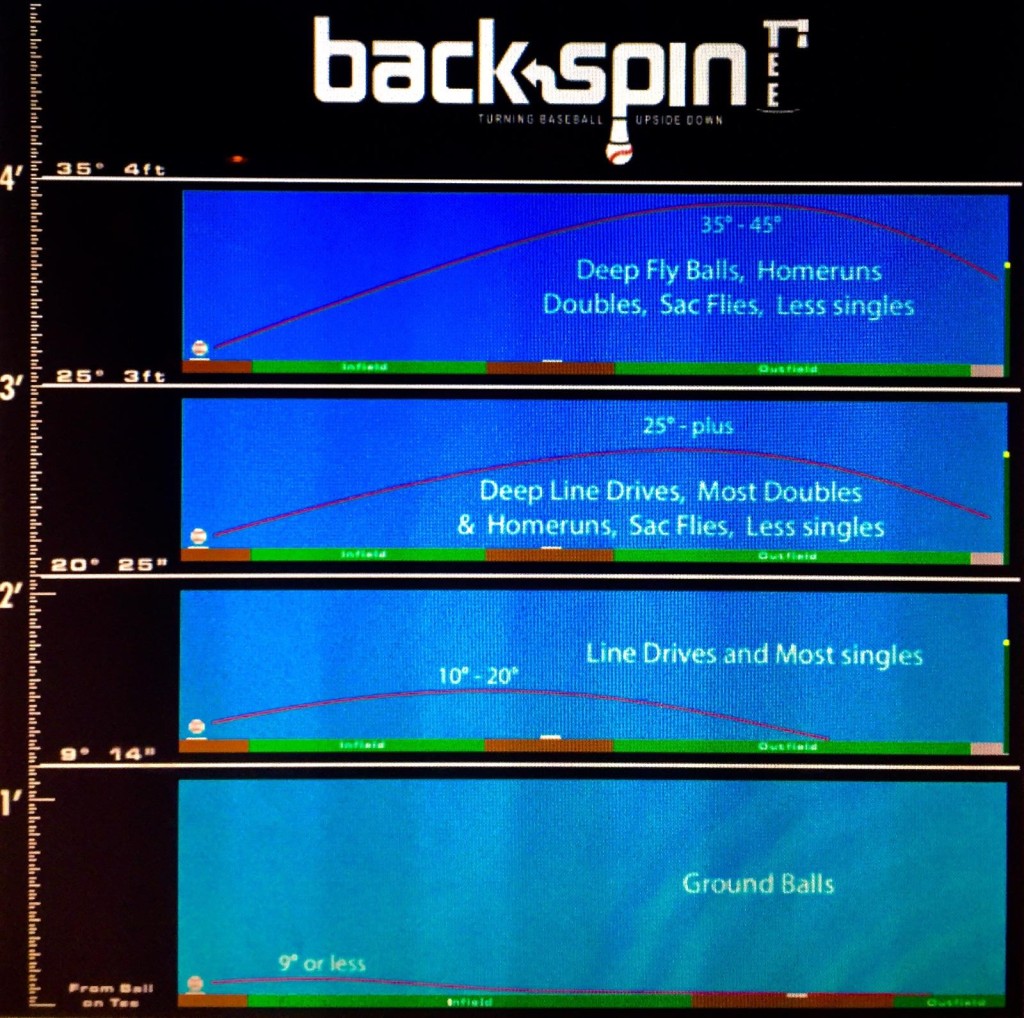
Launch angle diagram comparing ground-balls to balls-in-the-air. Baseball hitting drills for kids infographic courtesy of the Colorado Rockies and the guys from BackSpinTee.com.
What I have a baseball hitting drills for kids beef with are coaches teaching hitters to hit the ball on the ground…ALL THE TIME!
As I mentioned before, DID YOU KNOW…line drives are balls in the air? I said it again!! Doesn’t take a physics professor to see that.
And if you forget every word in this Ground-ball Rant, then PLEASE PLEASE PLEASE remember the following words that are coming from my brain to fingers to keyboard…
Pitchers Want Hitters Hitting the Ball on the Ground!
What vertical part of the zone do pitching coaches teach their pitchers to primarily use? “Keep the ball down!”…is what they say. Now, what part of the ball are pitchers HOPING hitters hit by keeping the ball down?
That’s right! The top half of the ball. Because, as the Backspin Tee ‘On Path Bottom Half’ graphic shows, hitting the top half of the ball induces top spin, driving the ball into the ground.
In other words, PITCHERS WANT HITTERS TO HIT THE BALL ON THE GROUND!!!
It’s all about seeking pleasure and avoiding pain. Pitchers know that they don’t get hurt (as much) with a ground-ball than with a ball-in-the-air. Look at the Sabermetrics, launch angles increase up in the zone, while they decrease down in the zone. This is FACT. So WHY the heck are hitting coaches teaching their hitters to primarily hit ground-balls?!
I seriously don’t know the answer…I’m as some would say, confused. Or is this some LARGE conspiracy of pitching instructors undermining our hitters? Let me give you another bit of baseball hitting drills for kids advice…don’t listen to pitching coaches teach hitting. Unless they’re aware of the strange duality between pitching and hitting strategy.
You see, they’ve been conditioned to induce ground-balls, so whether they’re conscious about it or not, to hitters, they’re promoting the VERY THING they use to get hitters out. Most of the pitching instructors in my area, who also teach hitting, instruct their hitters to swing down on the ball. Coincidence?
CLICK HERE for a link to a Beyond the Boxscore article titled, “Scooter Gennett and ground balls”. The sub-title says it all, “Scooter Gennett’s offense has declined every year since he broke into Major League Baseball, are ground balls the reason?”
Okay, moving on…
Before getting into Jean Claude Van Damme round-house kicking those ground-ball teaching batting coach arguments included at the beginning of this post, I want you to answer the following question…
Which is Better? A Ground Ball Pitcher or a Fly Ball Pitcher
Let’s wet the whistle with a FanGraphs.com article titled, “Which is Better? A Ground Ball Pitcher or a Fly Ball Pitcher”. This article is an interesting MUST READ for all. However, one graphic I wanted to draw your attention to, is this one:

AVG = Batting Average, ISO = “Isolated Slugging%” or Raw Power, & wOBA = weighted On-Base AVG. Baseball hitting drills for kids graph compliments of FanGraphs.com
What’s obvious in the results for each type of ball in play, is the value of the Line Drive (highlighted in yellow). I think even “Pro-Ground-ballers” agree that the line drive is the way to go.
But if given a choice to pick the lesser of two evils, the Pro-Ground-ball coach will unanimously pick the ground-ball.
But look at the difference in productivity between the Ground-ball and Fly-ball…
- A 32-point increase in Batting Average with Ground-ball over a Fly-ball, however
- A 358-point INCREASE in ISO (or raw power) with Fly-balls over Ground-balls…AND
- A 115-point INCREASE in weighted On-Base Average with Fly-Balls over Ground-balls, which according to FanGraphs.com,
“Weighted On-Base Average combines all the different aspects of hitting into one metric, weighting each of them in proportion to their actual run value. While batting average, on-base percentage, and slugging percentage fall short in accuracy and scope, wOBA measures and captures offensive value more accurately and comprehensively.”
Well Fly-balls, it’s unanimous…2 out of 3 will get you in the Hall Of Fame 😛 lol
Also, since we’re on the subject, check out this Launch Angle infographic of Bryce Harper that was posted by @PinkmanBaseball:
Think Launch Angle matters? check out these numbers. #baseball #mlb #HittingTwitter #NCAA @HitTraxBaseball pic.twitter.com/EjWFN9XKDx
— Pinkman Baseball (@PinkmanBaseball) February 7, 2016
Oh HAPPY DAY!
Key in on Bryce Harper’s offensive productivity from 10 to 30-degrees of Launch Angle! Did you pick up on the KEY message? Killed two birds with one stone there…
- Key Message #1: This shows hitters aren’t productive unless they’re swinging UP to the ball (not down)…
- Key Message #2: And if a 9-degree Launch Angle, or less (see ‘Backspin’ image #2 above), is a ground-ball, WATCH how B. Harper’s average AND power numbers skyrocket once he gets to over a 10-degree Launch Angle.
Situational hitting aside, remind me again WHY we’re teaching baseball hitting drills for kids that promote grounders? So far, I hope this has helped the ‘fence-sitters’ see the light. Now, let’s zero in on those not even close to the fence. You know who you are. I may not get you over to the ‘Light Side’ reading this whole post…
BUT,
The information will fester in a Fixed Mindset brain, like an open wound, and with time, I’m confident you’ll make your way to the Lighter Side of effective hitting. Don’t worry, I’ll be a patient grasshopper. I don’t care what level of play you coach.
YOU WILL BE MINE Ferris Bueller!
Onwards…
The ground-balls are gross hitting coach will go on and on about…
How many games they’ve won with grounders
This is a subjective statement, and an exaggeration at BEST. First of all, show me the numbers on how many games were won with a seeing-eye single versus a double, triple, or dinger. Give me 5-years of MLB data. Better yet, how many “go-ahead runs” were by single or extra base hit? I’d love to see the REAL numbers. What is FACT, in the 2017 World Series, the Astros WOULD NOT HAVE WON by hitting a bunch of singles.
Seriously though, of all the baseball and softball games being played on the planet, how many late inning heroic game winners are being hit on the ground? AND, of those game winning ground-balls, how many of those WERE INTENDED to be on the ground by the hitter and/or coach?
Let’s get personal with you coaches who obsessively LOVE GAME WINNING SINGLES ON THE GROUND, here’s what I want you to do…track your game winning hits, and report back. Don’t cheat though, and fudge the numbers to save face. My hypothesis is, ground-balls WILL NOT be the number one game winning or “go-ahead run” vehicle. I’ve seen too many game winning balls-in-the-air (line drives and fly-balls), in my playing career, to accept that ground-balls get the job done better.
The ground-ball obsessed coaches, go on and on about…
How ground-ball fielding percentage is way lower than with fly-balls
This statement proves a statistically flawed argument. Here’s the information that we need to put it to the test:
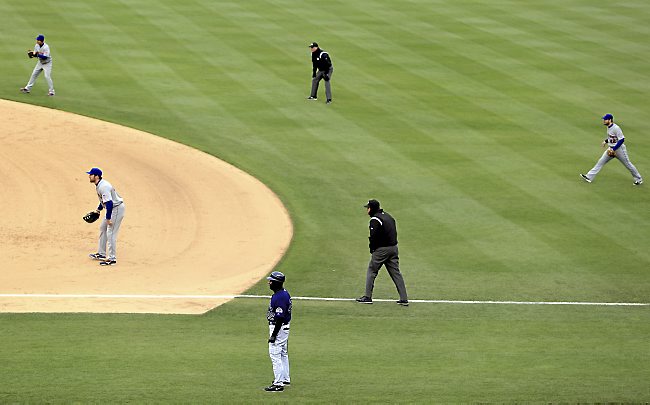
The New York Mets infield plays a defensive shift against Carlos Gonzalez of the Colorado Rockies at Coors Field on April 16, 2013 in Denver, Colorado. (Baseball hitting drills for kids photo by Doug Pensinger/Getty Images)
- Total number of ground-balls hit in latest MLB season, and
- Total number of fly-balls hit in latest MLB season.
I’m willing to bet, there were WAY more ground-balls hit than fly-balls. More statistical data points translate to lower overall averages. And the reverse is typically true of less statistical information.
Riddle me this,
…if fielding percentages for outfielders are higher, then WHY don’t we teach our pitchers to pitch to the top of zone, than the bottom? Doesn’t that sound logical?…“Hey, if our outfielders are the better fielders, then get hitters to hit more balls to them.”
Here’s what I thought up ALL BY MYSELF, there are FIVE fielding infielders (including the pitcher), and only THREE outfielders. There’s more space in the outfield and less fielders…WHY don’t we hit it out there? Even my four year old can see the superiority in that baseball hitting drills for kids strategy.
One of my readers Brian Ingram, shared this:
“Just read the article about the flawed ground ball approach and wanted to say I completely agree. also wanted to add on to the idea of 5 infielders vs 3 outfielders, (which I thought of too as soon as I read the title and was happy you touched on it) was that those 5 infielders have less total area to cover on ground balls than the 3 outfielders do on balls in the air.
And the space where ground balls get through is far smaller than the area where balls in the air go for hits. Also, like you showed in the article, ground balls are either hard or soft. Balls in the air though can be shallow line drives, deep line drives, deep fly balls, and bloop hits.
In addition, higher chance of getting on base from things like bad reads, ball getting lost in the sun or lights, wind issues, knuckling line drives, etc.
Also outfielders have a limit of the outfield fence on how far they can go back to catch a ball. Infielders don’t have to deal with those issues, which also count as hits not errors leading to the discrepancy in fielding percentage. All of those things taken into consideration leads to the conclusion that odds of reaching base safely is much high hitting the ball in the air than on the ground. All in all I loved the article and couldn’t agree more.”
Thanks for sharing that Brian (who’s applying to be in the Kinesiology Department at Fresno State in the Fall). Also worth noting is the fact MLB teams are giving up in an infielder to the outfield to concede the ground-ball…WHY??! Because they’re taking the easy risk ground-balls don’t do damage like an extra base hit. Heck, you don’t have to work for NASA to figure this stuff out.
Here’s another thought to consider about this shifted infielder into the outfield…in using a defensive shift, WHY would we put an extra infielder into the outfield, if the outfielders – statistically speaking – were better at fielding? After all, they don’t NEED anymore help, right?!
Because according to you, outfielders HAVE TO BE BETTER fielders than infielders right? That’s what the stats tell us!!!

Yoda (The Force) photo courtesy: BusinessInsider.com
Or how about this, since we shifted the infielder positionally into the outfield, does he/she instantaneously inherit the stellar fielding percentage of playing on the luscious outfield grass? Sounds like “the Force” in Star Wars 😀 lol
Statistically speaking, comparing an infielders fielding percentage to an outfielders is comparing apples to oranges. Are we done here? Good.
The ground-ball obsessed coaches, go on and on about…
That it’s much easier to catch a fly ball
Is it? Steps to processing a ground-ball:
- Field it,
- Throw it,
- Catch it.
Steps to processing a fly-ball:
- Move under it,
- Catch it.
Hey look! One less step! You may be onto something here…but are you? I played the outfield from my sophomore year in High School through all 4-years at Fresno State, so I know how easy AND difficult it is. Again, you’re one of three fielders in the biggest part of a baseball or softball field.
Ask Jose Canseco how easy it is to catch this “fly ball”:
Also, ask an infielder going back to catch a fly-ball in the shallow outfield, with a converging outfielder coming towards them, how easy catching that fly-ball is.
At Fresno State, legendary Coach Bob Bennett constantly had us working on this type of drill called “Pop-fly Priorities”. We were drilled to the point of throwing up, AND even still, occasionally the ball dropped into ‘no-man’s land’ in games.
I’d love to take the “ground-ball obsessed coach” out and hit them fly-balls, and have them track it down. They’re much harder to track than you think. And things move A LOT faster in the outfield, most of the time you’re on a dead sprint to get from point A to B.
And, when an outfielder makes a mistake, runners advance at least one extra base. If infielders bobble a ball, typically, they still have time to recover and get the out. In other words, an outfielder’s mistake is magnified.
Besides, my friends who’ve played in the Big Leagues say the outfield is where misfit infielders go, which brings the quality of overall outfield play down at the highest level. Ask any converted outfielder how challenging it is to track a ball effectively off a bat 😉
Which leads me to,
The “Ground-ball obsessed coaches”, go on and on about…
How great outfielders track fly balls
But you’re thinking, well, MLB and college outfielders (both baseball and softball) are great athletes, and they track and catch everything in the air. This simply isn’t true. They don’t. Not even ‘cans-of-corn’ are off limits to being dropped. Don’t believe me? Go to YouTube and type in “mlb dropped fly ball”, and count how many, what you think are ‘cans-of-corns’, are dropped…
And for you college coaches who still don’t agree…this season, track how many balls are dropped by your outfielders this year…AND the run scoring result of that action. Then track how many ground-balls are dropped by your infielders this year…AND the run scoring result of that action.
My point is, NOT ALL fly-balls to outfielders are caught, and when they aren’t, extra bases are taken. Heck, extra bases are taken if an outfielder takes a bit too long fielding a line drive/ground-ball in front of them! I know because I took plenty of extra bases on them in my time. If an infielder drops a ball, most of the time, it’s no big deal, at least if the runner isn’t fleet of foot. All is forgiven, minimal damage done.
Not outfielders, no-no. The “ground-ball obsessed coaches”, go on and on about…
How more can go wrong with the defense keeping the ball on the ground
My good friend Taylor Gardner, and owner of the BackSpin batting tee, shared a CLASSIC baseball hitting drills for kids response to the aforementioned statement on Facebook (and one I echoed earlier in this post). He said:
“Groundball supporters…why do pitchers try and keep the ball down in the zone? ……………..They WANT you to hit a groundball. If you don’t believe that, then start telling your pitchers to live about chest high in the zone and see how many pop ups you can get in the game. Ha ha…you should bring your center fielder into the infield and play with an extra infielder because you seem to be so scared of the groundballs (which are better right)?”
This is a common argument amongst Little League coaches…
“Hit the ball on the ground because the other team can’t play catch!”
But what happens when they meet a team that can play catch? What then? Let me give a clue…they get beat. And IF they get a runner on base, then they’re another ground-ball away from a double play!!! If the other team can play catch, no more getting runners on base because of errors…no more auto-runs to second after a walk. NOTHING. Your team is SHUT DOWN. Did you miss that? Let me repeat, your misled offensive strategy is SHUT DOWN.
This is WHY, when and if my 4yo son plays baseball, his team will be the most disciplined group of young men at playing catch. If I come across YOUR ground-ball hitting team, we will CRUSH YOU. You better have quality pitching, because YOU WILL LOSE! And you won’t know how it happened…why it happened…or what happened.
Worst of all, your troops won’t be able to recover because you’ve taught them baseball hitting drills for kids that primarily focus on hitting the ball on the ground. Have you ever been in a hopeless situation like that? It’s only a matter of time, if you keep doing what you’re doing. The sad part is if your ground-ball hitting team is lucky enough to make it to the championship game, guess what, most likely the other team will be REAL GOOD at playing catch. What do you think will happen then?
What’s more,
Guess what happens to ground-ball fielding difficulty after graduating to the BIG field…?
- Infielders are deeper – increasing their fielding range,
- Athletes get more athletic – enabling them a farther “reach”,
- Players get better at playing catch (naturally course of skill acquisition), and
- With 90-foot bases (instead of 60 to 70-foot), fielders have more time to field, gather, and throw. In other words, more can go wrong with fielding a ground-ball, and the defense still recording a putout because they have more time.
But you “ground-ball obsessed” Little League coaches don’t care anyway, it’ll be the next coaches problem when they get into Middle School, right? Fastpitch softball is a little different…the young ladies will grow into the “smaller” field. However, points ONE through THREE above still hold true.
One last baseball hitting drills for kids point I want to make on this, comes from a Beyond The Box Score article titled, “Do Hard Hit Ground Balls Produce More Errors?” The data from the above post analysis suggests errors don’t start consistently climbing until Ball Exit Speeds (the speed of the ball coming off the bat) reaches around 95-mph. This data comes from Major League players, by the way.
It goes to show that you have to hit the ball pretty dang hard to force the defense to make an error. To put a 95-mph BES into perspective, this ball has the ability to travel 380-feet with an optimal ball launch angle (1-mph of BES = 4-feet of distance). Are your High School hitters hitting even 85 to 90-mph Ball Exit Speeds in games? If not, then maybe you should re-work your ground ball hitting strategy.
The other thing I’ve heard from ground-ball obsessed coaches is, “Well, you can’t get a bad hop in the air.” Really!? So you’re banking winning versus losing on something out of your control? In other words, you’re “hoping” and “praying” for the ground-balls your hitters hit to take a bad hop?! That’s laughable. Errors are a gift, not something you should expect. And at the higher levels, there are less “gifts”. The best coaches (and players) don’t focus baseball hitting drills for kids on the uncontrollable. Adapt or die.
You gotta check out this post titled, “The Shocking Mistake Killing Run Production (MUST Read For Ground-ball Hitting Coaches): Ground-ball Hitting Approaches May Be Causing You To Lose Out On Producing MASSIVE Runs”
The “ground-ball obsessed coaches”, go on and on about…
How some of the most winningest coaches in college baseball history, Gordie Gillespie and Augie Garrido stress keeping the ball on the ground to their hitters

MANHATTAN, KS – APRIL 26: Head coach Augie Garrido of the Texas Longhorns looks out onto the field from the dugout during a game against the Kansas State Wildcats at Tointon Stadium April 26, 2008 in Manhattan, Kansas. Kansas State defeated Texas 4-1. (Photo by Peter Aiken/Getty Images)
This is where I really get fired up because this kind of baseball hitting drills for kids statement is:
- A “That Guy” type of comment,
- Dumb.
It’s a great example of making a blanket statement WITHOUT knowing who you’re talking to. What’s interesting to note is after this person said this, and I responded with the following, they never responded back.
Now, I can’t speak for Coach Gordie Gillespie, but here’s my connection to Coach Augie Garrido…Coach Garrido played for Fresno State (my alma matar) back when Coach Pete Beiden was the head coach. I believe, Coach Garrido also played with Coach Bob Bennett (but I could be wrong there), who was my coach the first three years I played at Fresno State.
Whether he played with Bennett or not, Coach Garrido learned from Beiden, just as Bennett did. So having never played for Garrido, I have a pretty good idea that Coach Beiden rubbed off on Garrido as he did on Bennett.
And Coach Bennett, NEVER told us, in the three years I played for him (and even me – a smaller hitter), to ever hit the ball on the ground…UNLESS I was popping up to much, which is adjustment advice. OR for situational hitting.
So my baseball hitting drills for kids hypothesis with Coach Garrido would echo the same Bennett-Beiden philosophy. I don’t think Coach Garrido compiled a collegiate record of 1950-919-9, and has taken his teams to 15 College World Series primarily by instructing his hitters to hit the ball on the ground.
Somebody close to Coach Garrido, ask him, and get back to me…PLEASE! I’m dying to be proven wrong. Besides, head coaches in the college and professional ranks are generalist. Let me clarify this, they typically don’t meddle in hitting or pitching aspects with a fine tooth comb. They have assistant coaches whose job it is to do that. In 3-years, I can count on one hand how many times Coach Bennett gave me hitting advice.
Head coaches should be like the CEO of a corporation…their concern is with big picture strategies, not on how TPS Reports are suppose to be written. Well, I commend you for making it this far! Either you’re:
- NOT one of the “ground-ball obsessed coaches” anymore, OR
- You’re ONE for a beating! lol
I assure you this rant is almost over, just a few more Karate chops I need to issue…the “ground-ball obsessed coaches”, go on and on about…
How you HAVE TO TEACH a 5’6″, 135-pound High School hitter to hit the ball on the ground because his batted ball distance maxes out at 250-feet!

Text from dad after 11yo son Orin hit a 300-foot bomb, weighing in at 98-pounds.
I’d LOVE to see the look on the face of the High School coach that said this, after I told him on Facebook that I have multiple 11yo hitters that hit the ball consistently over 300-feet, and get this, they did it while weighing less than 100-pounds…AND not just once, but multiple times!!
I’m sure the look was precious. Obviously, this coach isn’t teaching effective baseball hitting drills for kids, and doesn’t know any better. You don’t know what you don’t know, right? There are certain things, mechanically speaking, that directly influence consistent power, hitting more line drives, and being on-time more often. Success leaves clues, and we can train it all.
I don’t care the size of the hitter, I’m going to teach them all how to drive the ball. It’s another tool for their tool belt. Besides, Physicist Dr. Alan Nathan told me in a phone conversation that bat speed is a better indicator of batted ball distance than body mass.
Yes, a smaller hitter’s role on the team may require them to be better at putting down a sacrifice bunt, hit-and-run, and/or slap hit (especially if they’re faster, or left handed), but ALL hitters MUST know how to drive the ball. Driving the ball SHOULD BE the default, NOT hitting the ball on the ground.
Look, there are thousands of ways to teach baseball hitting drills for kids. Just like you can eat soup with a spoon, fork, or knife, but only one tool is more effective. Teaching hitters is the same. Stick to applying human movement principles validated by REAL science, NOT because-I-said-so “bro-science”, to hitting a ball, and your hitters will get predictably positive results.
And last, but certainly not least…the “ground-ball obsessed coaches”, go on and on about…
How even pro coaches and “great hitting instructors” never promote hitting fly-balls
This statement is also subjective. Please define “great hitting instructors”. Does what Alex Rodriguez and Albert Pujols say about hitting make them a great hitting instructor? Did Ted Williams and Tony Gwynn do a COMPLETE job of analyzing in retrospect, how they did what they did? Ted Williams came close, but still was quite far from filling in between the lines.
How about Dusty Baker in his hitting book. Mike Schmidt? Charlie Lau? Look, I’m not putting down any of these legendary people, but we have to have a higher standard than just somebody’s hitting “philosophy” or “bro-science”. We have to teach human movement principles that are validated by REAL science, to hitting a ball.
Simple as that.
So, my first baseball hitting drills for kids question to you is, if you believe the above statement, then whose kool-aid are you drinking? Who do you consider a “great hitting instructor”? And last time I checked on FanGraphs, Ted Williams, Pujols, A-Rod, Mike Trout, Nolan Arenado, Bautista, and Donaldson ARE NOT trying to hit the ball on the ground. Don’t believe me? Look at their ground-ball, line drive, fly ball, and home-run to fly-ball ratios. I guarantee you’ll see ALL of them being below average in their ground-balls rates, while being above average in the others.
Please check…I’ll wait. Oftentimes, what Major League hitters say they’re doing is not what we see them do on slow motion analysis. What’s real and what’s feel are two totally different things. I GUARANTEE, most of the effective hitting gurus online, are telling their hitters to drive the ball IN THE AIR with AUTHORITY. Again, that includes line drives.
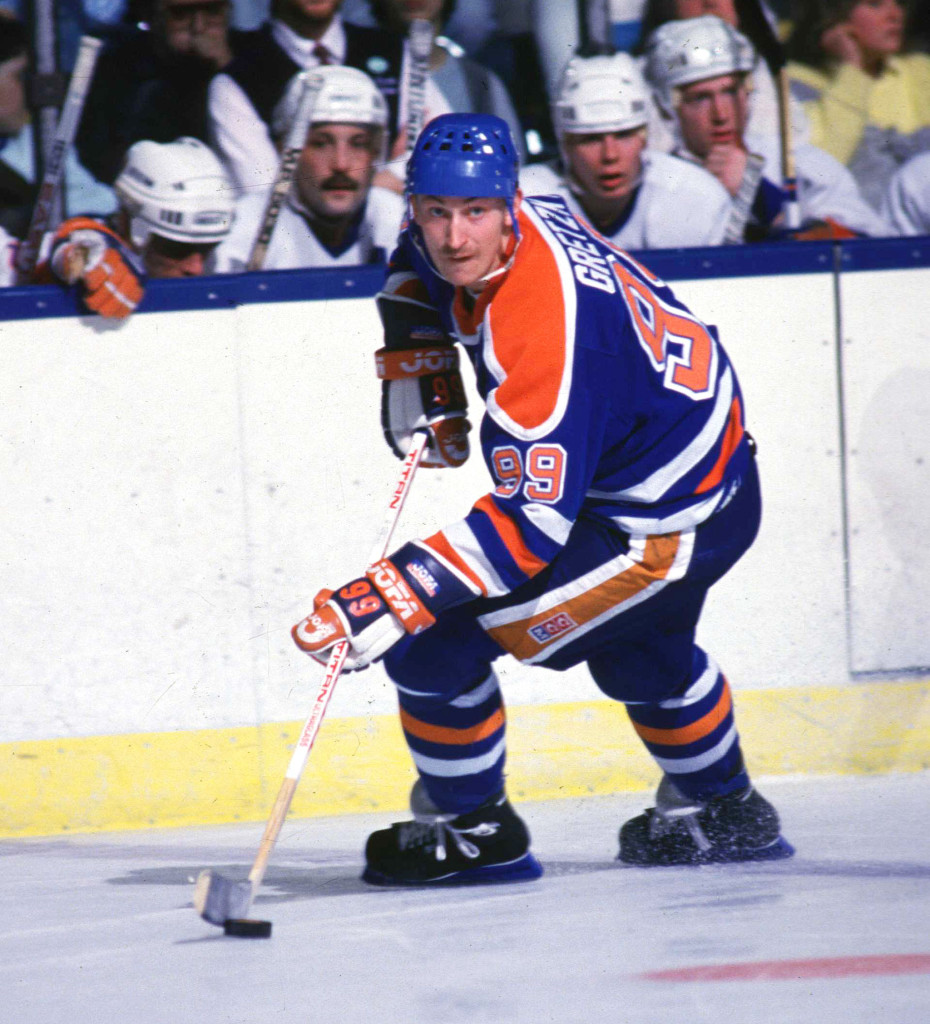
Wayne Gretzky image courtesy: http://forum.mmatd.com/
So you can keep telling yourself these baseball hitting drills for kids stories (i.e. the “ground-ball obsessed coaching” statements above), and get mediocre results with your hitters…
Or you can follow what Hockey great Wayne Gretzky says,
“A good hockey player plays where the puck is. A great hockey player plays where the puck is going to be.”
Teaching baseball hitting drills for kids to primarily hit ground-balls is ‘where the puck is.” Teaching them to hit the ball in the air is ‘where the puck is going to be’.
Think it’s impossible for young hitters to learn? You’re wrong. You may not know how to teach baseball hitting drills for kids to optimize launch angles. And that’s okay! Get educated. Don’t be an armchair quarterback. Opinions are NOT facts.
Don’t be afraid of setting young hitters up for failure in teaching them to hit more line drives. Shoot for the stars to land in the clouds. Have a higher standard for your hitters. In Pre-Kindergarten, my 5-year-old son’s teachers are getting him ready for Kindergarten. THE NEXT LEVEL! Coaches MUST do the same! Stretching requires some pain, but it’s how we grow.
And if you’re not growing, you’re dying. Swallow your pride, and come over to the Light Side!



